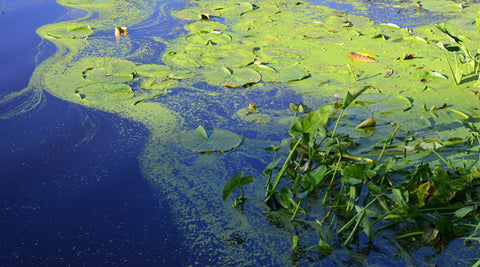6 ways to keep your dog safe in water

If you own water loving dog you will know that trips to the local lake or reservoir are a special treat!
However, during hot spells especially heatwaves your dogs paddle could be fatal if the water is contaminated with Blue Green Algae.
Do you know the signs to look out for?
Here are 6 ways to spot the dangers!
1/ What is blue-green algae?
Blue green algae, or cyanobacteria, are a group of bacteria that can contain dangerous toxins which can be harmful and potentially fatal to pets, livestock and birds if ingested even in small quantities. They are found throughout the UK in some ponds, streams, lakes, rivers and thrive in warm and nutrient rich water
The algae may appear as green or greenish-brown scum on the surface of water and in warm weather it can form large blooms that contaminate the water. Dogs can swallow it by drinking water from an affected lake, river or pond or while licking their fur after going for a swim.
2/ Is blue-green algae toxic to dogs?
It has recently been spotted in water bodies across the UK, including several locations in the Central Belt of Scotland, as well as in Derbyshire, the Midlands, Essex, Pembrokeshire and the Brecon Beacons.
Earlier this month, in an incident in the Scottish Highlands, a dog died after coming into contact with suspected blue-green algae at Loch Awe.
3/ What does blue-green algae look like?
Water that contains blue-green algae may appear a different colour, often looking like pea soup.
Blooms are not always large and can sometime be seen in smaller areas of the water close to the shore. The algae may be blue-green in colour, or can even be red, brown or black. The water may sometimes smell musty, earthy or grassy, and you may sometimes see foam along the shoreline.
4/ What should I do if I think a waterbody is contaminated by blue-green algae?
If you come across a body of water (in the UK) that you think may contain blue-green algae you should report it to the Environment Agency which has a 24-hour incident hotline (telephone: 0800 80 70 60).
You can also find out if there are any suspected blooms in your area by downloading the Bloomin Algae App using the following link
https://www.ceh.ac.uk/our-science/projects/bloomin-algae
5/ What are the symptoms of Blue green Algae poisoning?
Symptoms of exposure can appear within a few minutes or hours, depending on the type of toxin ingested, and commonly include vomiting, diarrhoea, drooling, disorientation, trouble breathing, seizures, and blood in faeces. If left untreated, it can cause liver damage and ultimately be rapidly fatal.
6/ What should I do if I think my dog has been poisoned by blue-green algae?
You should take your dog to the vet urgently
Seeking treatment quickly is vital in helping improve their chances of survival. Blue-green algae often needs rapid treatment, so it is important that your dog sees a vet straight away
If possible, get someone to call ahead to the vet to let them know you are on your way. This will give them time to prepare for when your dog arrives
If you’re not near your home, you can find a vet near you on the Royal College of Veterinary Surgeon’s website
Sources:
www.yourthurrock.com
www.thekennelclub.org.uk
www.vets4pets.com

